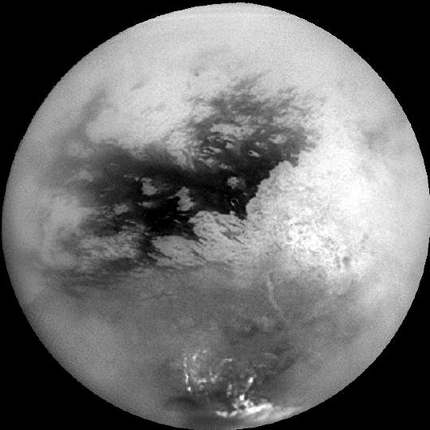[/caption]
It seems Titan is getting more Earth-like all the time. There are lakes, rainfall (never mind that any liquids on Titan are frigid hydrocarbons), dust storms, lightning and all sorts of other activity going on it the atmosphere, along with clouds. And now, not just any clouds but cirrus clouds, very similar to what we have on Earth: thin, wispy clouds of ice particles high in the atmosphere. A team of researchers at NASA’s Goddard Space Flight Center say that unlike Titan’s brownish haze, the ice clouds are pearly white.
“This is the first time we have been able to get details about these clouds,” said Robert Samuelson, an emeritus scientist at Goddard and the co-author of a new paper published in the journal Icarus. “Previously, we had a lot of information about the gases in Titan’s atmosphere but not much about the [high-altitude] clouds.”
Using the Composite Infrared Spectrometer (CIRS) on NASA’s Cassini spacecraft scientists can get a “weather report” of sorts. Previously, scientists have found that Titan’s intriguing atmosphere has a one-way cycle that delivers hydrocarbons and other organic compounds to the ground as precipitation.
Those compounds don’t evaporate to replenish the atmosphere, but somehow the supply has not run out.
Additionally, puffy methane and ethane clouds had been found before by ground-based observers and in images taken by Cassini. But these new clouds are much thinner and located higher in the atmosphere.
“They are very tenuous and very easy to miss,” said Carrie Anderson, the paper’s lead author. “The only earlier hints that they existed were faint glimpses that NASA’s Voyager 1 spacecraft caught as it flew by Titan in 1980.”
So what are these cirrus clouds made of?

More than a half-dozen hydrocarbons have been identified in gas form in Titan’s atmosphere, but many scientists feel there are probably many more that haven’t yet been identified.
The clouds on Titan can’t be made from water because of the planet’s extreme cold. “If Titan has any water on the surface, it would be solid as a rock,” said Goddard’s Michael Flasar, the Principal Investigator for CIRS.
Instead, the key ingredient is likely methane. High in the atmosphere, some of the methane breaks up and reforms into ethane and other hydrocarbons, or combines with nitrogen to make materials called nitriles. Any of these compounds can probably form clouds if enough accumulates in a sufficiently cold area.
To find these cloud, the team focuses on the observations made when CIRS is positioned to peer into the atmosphere at an angle, grazing the edge of Titan. This path through the atmosphere is longer than the one when the spacecraft looks straight down at the surface. Planetary scientists call this “viewing on the limb,” and it raises the odds of encountering enough molecules of interest to yield a strong signal.
So, when the researchers look at the data, they can separate the telltale signatures of ice clouds from the other aerosols in the atmosphere. “These beautiful, beautiful ice clouds are optically thin, and they’re diffuse,” said Anderson. “But we were able to pick up on them because of the long path lengths of the observations.”
NASA has a long article that describes these new observations in more detail.


never mind that any liquids on Titan are frigid hydrocarbons
Well, you have to remember that a lot of planetary scientists are based around Los Angeles, so their idea of ‘Earthlike’ may not exactly be typical…
I find it VERY interesting how we make the comparison between our water cycle atmosphere and Titan’s methane cycle. Extending the envelope to include possible biologically active lifeforms has me wondering just how far biological activity might reach? If one end of this scale is cryogenic life, then the other end might be pyrogenic? Perhaps there are beings that exist within the atmosphere’s of stars? Does that sound absurd? How about entities that exist WITHIN the crust of a planet? Or perhaps ‘free floaters’ living in the spaces between stars? IF there are such beings, I’d have some questions for them… First of all, I’d ask how they experienced time? Then I’d ask if they knew of other even more exotic realms for life? Indeed… we may find that not only is the universe inhabited, but that it is alive!
Don’t forget life based on heavy metals that lives in seas of lava on the sunward side of tidally locked super-Earths (Like COROT 7b).
Or life based on boron that exists in high pressure liquid hydrogen at the center of a gas giant.
@AQUA: I want some of what you’re smoking! I just love articles about Titan, what an intruiging(sp?) world. Let’s get a rover to the surface, and quickly please!
Prosit! A rover on the surface? Now THAT would be quite the challenge! ..so cold! Materials selection for the rover the challenge…
Errr, intriguing!
A challenge indeed, but so was landing on the Moon in ’69. Just think what we may find on Titan.